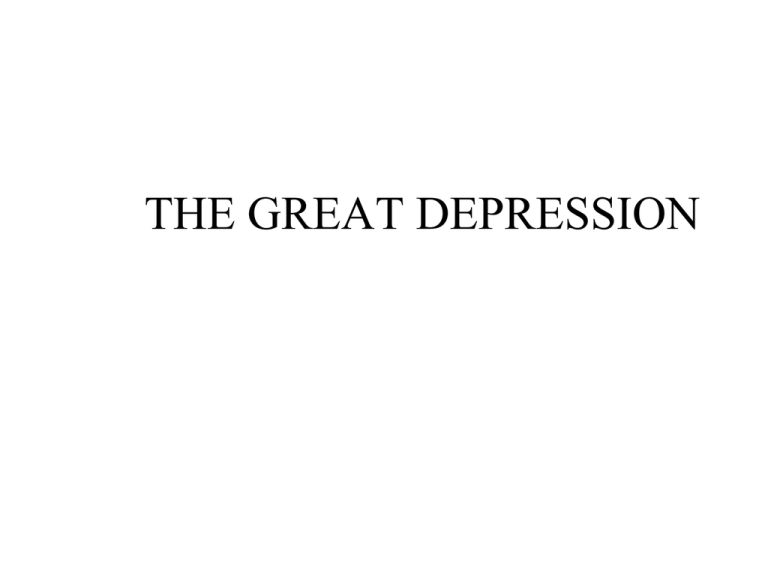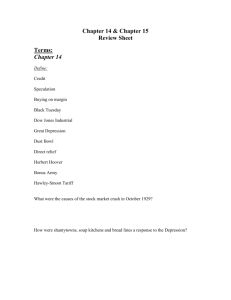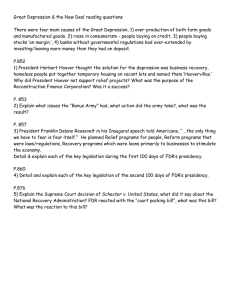THE GREAT DEPRESSION
advertisement

THE GREAT DEPRESSION What were the warning signs of the Great Depression? • Railroads, textiles, and steel were barely making a profit. • Farmers faced problems. • Consumers buying on credit. • Uneven income distribution. • Stock Marketspeculation and buying on margin What was Black Tuesday? • October 29, 1929Lose of 16.4 million dollars. • Stock Market Crash • People who bought stocks on credit were stuck with huge debts as prices dipped and others lost most of their savings. What was the Great Depression? • Period from 1929-1940, economy went down and unemployment rose dramatically. • Goods and service cut in half. • At height, 25% unemployment. • Led to worldwide depression. What was the Hawley-Smoot Tariff (1930)? • Highest protective tariff in U.S. history. • Designed to protect farmers and manufacturers. • Had opposite effect and reduced trade with other countries. • Other countries raised their own tariffs and hurt American economy. How were average people’s lives affected by the Depression? • Lost jobs, homes, and life savings. • Shantytowns- little towns that were shacks. • Soup kitchens- offering free or low cost food • Bread lines- charities giving away food. • Conditions for minority groups were worse because of job competition and discrimination. What was the Depression like for farmers? • Some farmers could still be self-sufficient and live off the land. • Many farmers lost their land because they could not pay the mortgage. • Dust Bowl- Severe drought from Kansas, Oklahoma, Texas, Nebraska forced many to move West. How were American families affected? Hoboes- men that wandered the country hitching rides on trains and sleeping under bridges • Women- starving and struggling to keep the family together. • Children- health problems, poor schools, worried if they would survive. • Many were ashamed of poverty and blamed themselves for not succeeding. What was Herbert Hoover’s philosophy? • Opposed direct relief to the needy. • Believed in voluntarism which was encouraging businesses to find solutions. • Worked horribly in fighting the Depression. • Hoover was heavily criticized and run out of office. What was the Boulder Dam? • Provided electricity and flood control • Regular water supply • Success of Herbert Hoover What was the Federal Home Loan Bank Act? • Passed by Herbert Hoover in 1932. • Lowered mortgages for homeowners and allowed farmers to refinance their farm loans. What was the Reconstruction Finance Corporation? • Authorized $2 billion for emergency financing in 1932. • Trickle Down Economics theory • Example of too little too late for government help. What was the Bonus Army? • 1932- WWI veterans demanded bonus that was due in 1945 early. • Hoover called in the troops to put down their demonstration. • Disaster for Hoover. Who was Franklin Delano Roosevelt? • Elected for 4 Presidential terms (1932-1945) • New Deal • “The only thing we have to fear is fear itself.” • Led America thru the Great Depression and World War II. • Optimism What was the New Deal? • Franklin D. Roosevelt’s plan to get America out of the Depression. • 3 parts- Relief, Recovery, Reform • Fireside chats- FDR’s radio addresses about the New Deal. What was the Glass-Steagall Act? • Passed in 1933. • Created the Federal Deposit Insurance Corporation. • Protected money in the banks. What was the Federal Securities Act? • Passed in 1933. • Required corporations to give company and stock information. • Created the Securities and Exchange Commission. • Regulates stock market. What was the Agricultural Adjustment Act? • AAA- raised crop prices by lowering farm production. • Criticized for slaughtered animals. • Did help farmers. • Eventually, found to be unconstitutional. What was the Tennessee Valley Authority? • TVA- Renovated dams, created thousands of jobs, provided flood control, hydroelectric power to impoverished areas. • Still exists today What was the Civilian Conservation Corps? • Passed in 1933. • Young men ages 1825 work on building roads, developing parks, planting trees, helping soil-erosion and flood control projects. What was the National Industrial Recovery Act (NIRA)? • Passed in 1933. • Provided money to states to create jobs in construction of schools and other community buildings. • Created NRA which set prices and established standards. • Found unconstitutional. What was the Civil Works Administration? • Provided 4 million immediate jobs in the winter of 1933-34. • Built 40,000 schools and paid 50,000 school teachers. • Built more than ½ million miles of roads. What organizations were created to give food, clothing, and shelter? • Home Owners Loan Corporation • Federal Housing Authority (FHA) • Federal Emergency Relief Act What were the criticisms of the New Deal? • Deficit spendingspending more money than you have • Father Charles Coughlin- wanted a guarantee of annual income, controversial • Dr. Francis TownsendWanted a plan for the elderly • Huey Long- Share Our Wealth Club, “Every Man is King”, ruthless Father Charles Coughlin Dr. Francis Townsend Huey Long Who was Eleanor Roosevelt? • Wife of FDR and First Lady • Great support and social reformer • Supporter of equal rights for women and minorities. What was the Works Progress Administration? • Part of Second New Deal • Headed by Harry Hopkins • Created jobs to build airports, roads, public buildings, murals, write slave narratives, and perform theater. What was the National Youth Administration? • Part of Second New Deal • Created jobs, education, counseling, and recreation for young people. What was the Wagner Act? • Federal government protected the rights of workers to join unions. • National Labor Relations Board- heard about unfair business practices. • Fair Labor Standards Act- Set maxim,um work hours to 44 hours per week. Banned hazardous work for those under 18. What was the Social Security Act? • Part of the Second New Deal. • Gave old age insurance for retirees over 65 and their spouses. • Unemployment compensation. • Aid to families with dependent children and disabled. Who was Frances Perkins? • FDR’s Secretary of Labor • First female in a Presidential cabinet. • 82% surveyed in 1936 said women should stay home. • Women faced discrimination at work. How did the Depression affect African Americans? • A. Philip Randolph- organized Sleeping Car Porters to fight for rights. • Mary McLeod Bethune- hired by FDR in NYA. Helped provide opportunities for minorities. • Marian Anderson- performs at Lincoln Memorial • FDR made small steps, but did not commit to civil rights Who was John Collier? • Created Indian Reorganization Act of 1934. • American Indian lands would belong to their tribe. • Reservation schools • Tribes could run their own reservations. What were the major movies of the Depression Era? • • • • • Gone With the Wind Wizard Of Oz Snow White Marx Brothers Films Mr. Smith Goes to Washington • Actors James Cagney and Clark Gable Marx Brothers Mr. Smith Goes to Washington What was popular on the radio? • Radio shows • Orson Welles and War of the Worlds • Lone Ranger • Jack Benny • Bob Hope • Burns and Allen Show • News Who were the famous artists of the Depression? • • • • • Diego Rivera Edward Hopper Grant Wood Thomas Hart Benton Singers Woody Guthrie (This Land Is Your Land) • Writers Richard Wright (Native Son) • John Steinbeck’s Grapes of Wrath Diego Rivera Edward Hopper Grant Wood (American Gothic) Thomas Hart Benton What is the impact of the New Deal? • Government has a responsibility to help people. • Some fear the increase in the size of government. • Others are happy the government has safety nets for the people. • Legacy of Social Security, TVA, SEC, and NLRB in today’s world.



